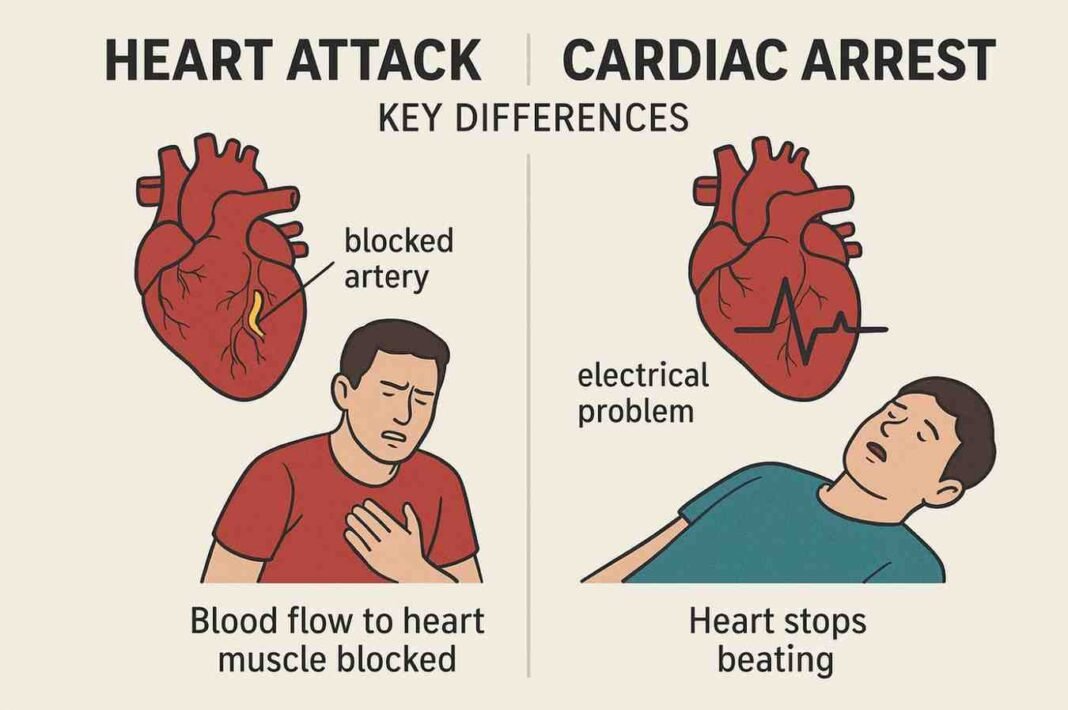Introduction
Cardiovascular diseases remain one of the leading causes of death globally, and among them, heart attacks and cardiac arrests are the most widely discussed. Though the terms are often used interchangeably, they refer to very different medical emergencies. A heart attack involves a blockage in blood flow to the heart muscle, while cardiac arrest is an electrical malfunction that causes the heart to stop beating effectively. Understanding their differences, symptoms, and precautions is critical for saving lives.
What Is a Heart Attack?
A heart attack, also known as a myocardial infarction, occurs when blood flow to a part of the heart muscle is blocked. This blockage is typically caused by a clot or a buildup of fatty deposits, also known as plaque, in the coronary arteries. Without sufficient oxygen, the heart muscle begins to suffer damage, which can become permanent if not treated promptly.
Common causes include coronary artery disease, blood clots, and artery spasms. Risk factors such as high cholesterol, high blood pressure, diabetes, obesity, smoking, stress, and a sedentary lifestyle increase the chances of experiencing a heart attack.
Symptoms of a Heart Attack
Unlike cardiac arrest, the onset of a heart attack is often gradual, with symptoms developing over hours or even days. Warning signs include:
-
Chest pain or pressure, often described as a squeezing or fullness sensation
-
Pain radiating to the left arm, neck, jaw, or back
-
Shortness of breath
-
Cold sweating and clammy skin
-
Nausea, vomiting, or indigestion-like discomfort
-
Fatigue or dizziness
In women, the elderly, or diabetic patients, symptoms may appear atypical, such as stomach pain, unusual fatigue, or breathlessness instead of severe chest pain.
What Is Cardiac Arrest?
A cardiac arrest, on the other hand, is a sudden and catastrophic event in which the heart stops beating due to an electrical malfunction. Unlike a heart attack, which is a “plumbing problem,” cardiac arrest is an “electrical problem.”
The most common causes include ventricular fibrillation, severe arrhythmias, a major heart attack, cardiomyopathy, congenital defects, or trauma. In some cases, drowning, electrocution, or a severe electrolyte imbalance can also trigger cardiac arrest.
Symptoms of Cardiac Arrest
The symptoms of cardiac arrest are immediate and dramatic. A person may suddenly collapse, lose consciousness, and stop breathing. In the absence of a pulse, circulation ceases, cutting off oxygen to the brain and vital organs. Unless CPR (Cardiopulmonary Resuscitation) and defibrillation are administered within minutes, death is inevitable.
Emergency Response and Treatment
For a heart attack, emergency response involves calling for medical help, keeping the patient calm, giving aspirin (unless contraindicated), and administering prescribed medications such as nitroglycerin. Hospital treatment may include clot-dissolving drugs or procedures like angioplasty and stent placement.
For cardiac arrest, the response is immediate CPR and use of an Automated External Defibrillator (AED). Bystanders who act quickly can make the difference between life and death, as survival rates drop drastically with every passing minute without intervention.
Precautions and Prevention
Prevention strategies for both conditions overlap significantly. Maintaining a heart-healthy lifestyle is key, which includes:
-
Regular exercise and maintaining a healthy weight
-
A diet rich in fruits, vegetables, whole grains, and lean proteins
-
Avoiding smoking and limiting alcohol intake
-
Managing stress effectively
-
Routine health check-ups to monitor cholesterol, blood pressure, and blood sugar
For those at high risk of cardiac arrest, an implantable cardioverter-defibrillator (ICD) may be recommended. Learning CPR and AED use is also an invaluable skill for community members, as immediate action can save countless lives.
Conclusion
While a heart attack is primarily a circulation problem and cardiac arrest is an electrical failure, both are medical emergencies requiring urgent attention. Public awareness, timely medical intervention, and preventive healthcare practices remain the strongest tools in reducing the global burden of cardiovascular deaths. Recognizing the difference is not just medical knowledge—it is lifesaving awareness.








